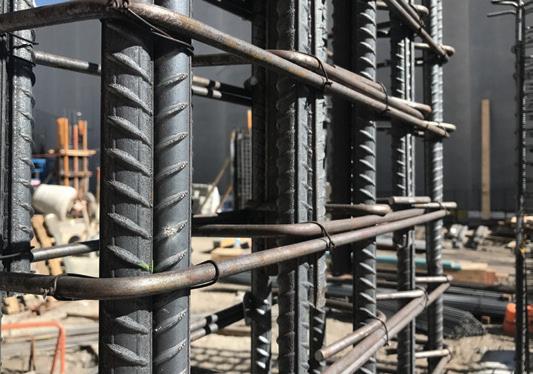
4 minute read
SAFETY AND RISK MANAGEMENT
MANAGING WORKSITE COVID-19 SAFETY RISKS
by Safe Work Australia
Advertisement
SAFETY AND RISK MANAGEMENT
Under Australia’s model Work Health and Safety (WHS) laws, employers are required to protect the health and safety of workers and others at the workplace by eliminating or minimising risks arising from work.
Safe Work Australia has developed guidance to help employers in the construction and infrastructure industries understand how WHS duties apply during the COVID-19 pandemic and what you can do to keep your workplace as safe as possible.
ASSESSING AND MANAGING RISKS
Exposure to COVID-19 is a foreseeable risk that all businesses in the construction and infrastructure sector need to manage.
In consultation with workers and their representatives, it’s essential to undertake a COVID-19 risk assessment. Look at the way you work to understand and quantify the risks to health and safety from COVID-19. You can find tools to help you conduct a risk assessment on the Safe Work Australia website.
Once you have identified the risks, implement control measures to address those risks, and review them. While each workplace and business will be different, there are a few key control measures that will apply across the construction and infrastructure sector.
PHYSICAL DISTANCING
Physical distancing is a key measure to manage risks from COVID-19 because the most likely way of catching the virus is by breathing in respiratory droplets from an infected person.
By ensuring there is at least 1.5 metres between workers where possible, you will reduce the likelihood of exposure to the virus.
You can put in place measures to maintain physical distancing in the workplace, including: ♦ Adjusting the workplace layout and workflows to enable workers to keep at least 1.5 metres apart ♦ Installing signage or wall or floor markings to identify 1.5 metres distance ♦ Using non face-to-face methods for meetings and training ♦ Minimising non-essential visitors ♦ Reducing the number of workers at the workplace or using common facilities at the same time, for example, by staggering start and finish times and meal breaks ♦ Ensuring each worker has their own equipment or tools
If physical distancing measures introduce new health and safety risks, for example if they impact communication or mean less people are doing a task, you need to manage those risks too.
CLEANING MEASURES
A key way to protect workers and others from the risk of exposure to COVID-19 is through cleaning and disinfecting measures.
Cleaning measures should include: ♦ Cleaning and disinfecting workplaces at least daily ♦ If the workplace operates in shifts, cleaning between shifts ♦ Cleaning shared equipment between uses, where practical ♦ Prioritising frequently touched surfaces, like door handles, lift buttons, tabletops, light switches, toilets and taps for cleaning and disinfection ♦ Directing workers to regularly clean personal items they use in the workplace, like glasses and phones, using disinfectant wipes GOOD HYGIENE
Good hygiene reduces the risk of exposure to COVID-19. To minimise the risk of exposure at your workplace, require everyone to practice good hygiene and provide appropriate hygiene facilities. Ensure workers and others at the workplace: ♦ Don’t come to work when they are unwell ♦ Regularly wash their hands with soap and water for at least 20 seconds and dry them completely ♦ Cover coughs and sneezes with their elbow or a clean tissue, and no spitting ♦ Avoid touching their face, eyes, nose and mouth ♦ Dispose of tissues and cigarette butts hygienically, for example in closed bins ♦ Wash body, hair, facial hair and clothes thoroughly every day ♦ Have no intentional physical contact, for example shaking hands
You need to provide washroom facilities that are in good working order and are properly stocked with toilet paper, soap, water and drying facilities - preferably single-use paper towels.
If handwashing facilities are limited, provide alcohol-based hand sanitiser at locations such as entry and exits.
OTHER THINGS YOU CAN DO TO KEEP WORKERS SAFE AND LIMIT THE SPREAD OF COVID-19 ♦ Put up posters around the workplace on physical distancing and handwashing ♦ Review regular deliveries and request contactless delivery. Check systems for e-invoicing are in place ♦ Instruct workers to have meetings by phone. If not possible, require they meet in a large space and keep meetings short ♦ Instruct workers to tell you if they are displaying symptoms of COVID-19, have been in close contact with a person who has COVID-19 or have been tested for COVID-19. ♦ Develop a plan to ensure business continuity if there is a suspected or confirmed outbreak of COVID-19 in your workplace
Remember, you must consult with workers and their representatives, like health and safety representatives (HSRs), on health and safety matters relating to COVID-19, including what control measures to put in place in your workplace.
CHECKLISTS AND TEMPLATES
The Safe Work Australia website is the central hub of COVID-19 work health and safety information for Australian workplaces.
Detailed guidance is available for the building and construction industry, covering 22 key topics including work health and safety duties, risk assessments, physical distancing, hygiene and cleaning.
A range of other resources including posters, checklists and templates are also available on the website in the COVID-19 business toolkit. To access the guidance and resources, go to safeworkaustralia.gov.au.










